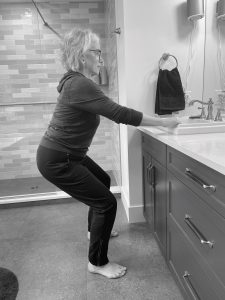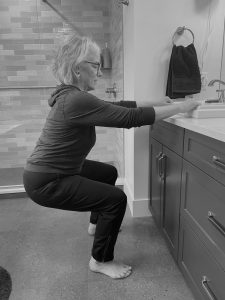
Let’s start by looking at what you can do to avoid constipation. Many folks think that what you eat is the only cause of constipation. However, if the poop still will not come out after increasing fiber and water, it is time to look at what is happening in the pelvic floor.
So what defines constipation? It generally means that there is a problem pooping and leads to having:
- Having fewer than three bowel movements in a week
- Feeling like the poop is still there after having a bowel movement
- Having a bloated abdomen, maybe nausea, and generally being uncomfortable in the abdominal area.
Unfortunately, many folks start dealing with these symptoms by straining on the toilet which can create its own set of problems like haemoorids, and even pelvic organ prolapse.
Being constipated is uncomfortable by itself, however it can also make you run to the bathroom frequently to go pee. I often see this in patients who are experiencing increased bladder urges in the peri to post menopause stage of life. The good news is that it does not have to be accepted as normal and why I always address constipation with my pelvic floor patients.
Constipation and Your Pelvic Floor
Constipation is often a symptom of a pelvic floor that is holding tension like a drum or has become lax like a hammock.
So how to get the pelvic floor to let the poop come out?
Learning how to let the poop out means coordinating the pelvic floor with the respiratory diaphragm. When the pelvic floor and the diaphragm are working together the pelvic floor can relax and we can let the poop out. When sitting on the toilet, remember to breathe and relax your tummy. Try to avoid holding your breath and straining.
Having a pelvic organ prolapse (POP) or a lax pelvic floor means that the connective tissue and muscles in the pelvic floor have lost structural integrity and strength respectively. This makes it challenging for the poop to find a pathway that has enough structure and strength to descend easily.
What to Do? Move your Body!
#1 Walking
Did you know that a 20-minute walk can be used as an anti- constipation tool? It stimulates gut motility and can be done anytime; however some find it helpful right after a meal! Try it and see what happens.
#2 Squat – A pelvic floor exercise that targets your hips and pelvic floor
Hold on to the counter or sink. Have feet hip width or wider apart. Lower your hips and let your sit bones come apart. Choose the squat depth that feels right for your knee comfort. Push down through both feet ( heels and toes) to rise – pull yourself up with your hands as much as needed. Repeat 2 x 5 per day or alternate days.
1/4 Squat

½ Squat

Deep Squat

4 Ways to Prevent Constipation
Choose one of the following 4 ways to address your constipation and note what happens. My patients often start with having their feet up on a stool to have a bowel movement and/or taking magnesium citrate.
#1 Drink Water
Use the color of your urine as a barometer for your hydration. If it is dark yellow, you are not getting enough fluid in your day. If it is light yellow or clear, you are getting enough liquid in your day.
#2 Fiber, Fiber, Fiber
Adding fiber to your diet will bulk up your poop and make it easier to pass. Options to increase your fiber include fresh fruits, veggies, beans, seeds, and whole grains. The recommendation is 25-35 grams/day. If you are not sure where to start you can start with adding Metamucil (powder or gummies) or add psyllium fiber to your breakfast diet (i.e. Bran Buds).
#3 Magnesium Citrate
Taking magnesium citrate brings water into the bowel and can make bowel movements softer, making it easier to pass. I ask my patients to check in with their pharmacist or doctor if they are concerned about starting a new supplement. Another safe option that many physicians often recommend is PEG (brand names include Restoralax and ClearLax).
#4 Use a Stool Under Your Feet
I share this video with my patients who are not familiar with the benefits of using a Squatty Potty or a regular bathroom stool with their bowel movements.
This Unicorn Changed the Way I Poop – #SquattyPotty https://www.youtube.com/watch?v=YbYWhdLO43Q

